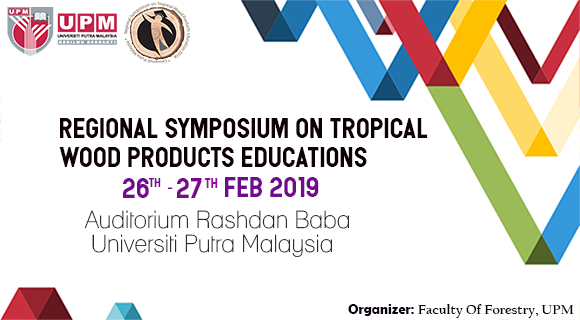Abstract Guidelines
HOW TO PREPARE YOUR EXTENDED ABSTRACT FOR THE REGIONAL SYMPOSIUM ON TROPICAL WOOD PRODUCTS EDUCATION 2018
Seca, G*a and T. Nitamib
aFaculty of Forestry, Universiti Putra Malaysia, 43400 UPM Serdang, Selangor, Malaysia.
bGraduate School of Agricultural and Life Sciences, The University of Tokyo, Tokyo, Japan.
Email: seca@upm.edu.my
Summary: This guide explains how to prepare the extended abstract for the International Conference on Sustainable Forest Development in View of Climate Change 2016. The extended abstract should be written in clear and concise English. It should be type written with MS Words for Windows XP on A4 paper with 11 pt of Arial font and single spacing. The extended abstract should contain “title, author’s name, author’s institution, postal and email address”. The extended abstract should have a summary (not exceeding 250 words), 3-6 keywords, introduction, materials and methods, results and discussion, acknowledgement (if any), and references (maximum of 6 most relevant references), in a maximum of 4 pages. The “title” of the extended abstract should be brief and informative.
Keywords: extended abstract, template, proceedings
INTRODUCTION
The “introduction” must give sufficient background for readers to understand and evaluate the results without having to read previous publications related to the topic. Use only references that really support the discussion. It should also include the objectives of the research. Common name of organisms (local name) must be followed by its (delete its) scientific name at first use.
All papers cited in the text of the extended abstract should be in parentheses, for example (Edwards, 1981; Cassel and Lal, 1992; Martin et al., 1992) except for when the author is mentioned. For example, "and the study of Cassel and Lal (1992) and Martin et al. (1992)".
MATERIALS AND METHODS
Materials should be included in the methods and contain a brief information on materials used in the experiments.
Methods should contain a brief technical information to explain how the author obtained the results. The methods also should be informative enough to enable the experiments to be reproduced successfully. Methods should not take more than a page. All the methods used must be cited with reference(s) from which the method was followed and should be given in parentheses, e.g. (Edwards, 1981; Cassel and Lal, 1992; Martin et al, 1990) except when the author is mentioned e.g., "according to the study of Cassel and Lal (1992) and Martin et al. (1990)".
RESULTS AND DISCUSSION
Results can be presented in the form of body text and if needed, display data in the form of “Tables or Figures”.
Table 1: Legend for Table must explain what the data represents
|
Production system |
Sources of organic matter |
Key constraints to adoption |
|
Rice |
Azolla, green manure, compost |
Poor water control, labor, P fertilizer |
|
Food crop |
Farmyard manure, food legume intercrops, grass weed residue |
Weed control, labor |
|
Plantation crops |
Cover crop legumes, food crop residues |
|
|
Hedgerow systems |
Shrub legumes |
Labor, land tenure |
Figure 1: Legend for figure must explain what the data represents. Where necessary, kindly show arrows to draw reader’s attention
The discussion section of the extended abstract should be focused on brief interpretation of results that are related to previously reported results. Restating methods, results, and other information presented in the discussion section must be avoided. References to the literature must be indicated in the text.
CONCLUSION
Conclusions should not repeat preceding statements, but extract the most important findings and identify their significance. With this template, we hope the authors can prepare their extended abstract for the symposium.
REFERENCES
List of references should be arranged alphabetically according to authors' names and chronologically for each author.
-In cited references, papers with single authorship should be cited before joint authorships.
-Publications by the same author(s) in the same year should be listed as 1984a, 1984b etc.
-Journal names should be spelled out in full.
-Use the following example to arrange your references:
- Edwards, C.A. (1981). Proceedings of a Workshop on the Role of Earthworms in the Stabilization of Organic Residues. Beechleaf Press, 61-85.
- Cassel, D.K. and Lal, R. (1992). Myths and Science of Soils in the Tropics. Soil Science Society of America, 61-89.
- Martin, A., Mariotti, A., Balesdent, J., Lavelle, P. and Vuattoux, R. (1990). Soil Biology and Biochemistry, 22, 517-523.
ACKNOWLEDGEMENT
Acknowledgement can be used to acknowledge financial support received in funding the research and to appreciate the institution or person(s) for their assistance in the research.

